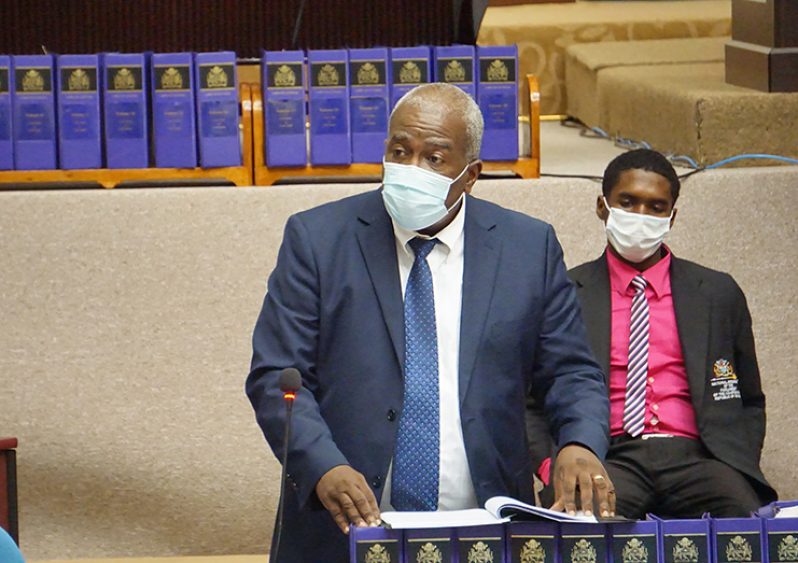– to fulfill immediate energy demands, Prime Minister Mark Phillips tells House
By Rabindra Rooplall
GOVERNMENT is aiming to fulfill immediate power demands with investments in ‘hydro’, solar and wind-powered infrastructures, Prime Minister (PM) Mark Phillips said on Friday.
The Prime Minister, who was at the time addressing the House during his budget presentation, reported that some $3 billion has been allocated for power generation.
This, he said, will enhance the quality of life of Guyanese as government tackles the irregular power supply and frequent blackouts.
“A total of $3B has been budgeted for power companies and projects across over Guyana: Lethem Power Company, Kwakwani Utilities, LINMINE, Mabaruma Power Company, Mahdia Power and Light Company Inc, Maruca Power and Light Company Inc, Mathew’s Ridge Power and Light Company Inc, Port Kaituma Power and Light Company,” PM Phillips said.
He said government will provide affordable, stable and reliable energy to benefit households and businesses, by utilising an energy mix of hydropower, solar and wind.
Government, he said, has already advanced a transparent Expressions of Interest (EoIs) process to engage local suppliers to fulfil the country’s growing immediate power demand.
Government, the prime minister said, is also pursuing a medium-to-long-term path that will allow for the completion of the Amaila Falls Hydro-Project while exploring the possibilities for the use of natural gas to ensure cheaper and more reliable electricity supply.
“We will continue to pursue low-carbon initiatives such as mini-hydro grid-tied systems as part of our energy diversification efforts. The GEA will install hydrological measurement equipment to assess the potential for mini and micro-hydropower development at various locations across the country,” the Prime Minister said.
He noted that data has already been collected at Paruima, in Region Seven (Cuyuni-Mazaruni), and the hydropower engineers are currently preparing a pre-feasibility study for the site.
Further, he said data is also currently being collected at Waramadong, also in Region Seven. Subject to travel restrictions as a result of the COVID-19 pandemic, hydrological loggers will soon be installed at Monkey Mountain, in Region Eight (Potaro-Siparuni), and Eclipse Falls in Region One (Barima-Waini) to determine the hydropower potential of those sites.
Adding that solar and wind systems for off-grid areas will be advanced as a top priority to provide renewable energy for the hinterland, PM Phillips said this will be done under the Hinterland Electrification Programme.
The GEA will also be advancing the installation of solar farms at Bartica and Lethem.
“The GEA is supporting the Hinterland Electrification Company Inc. (HECI) by conducting Energy Needs Assessments for all 200+ hinterland communities across our country. Assessments have already been completed at Sebai, Mainstay/Whyaka and Tapakuma/St. Denny’s, Moraikobai, Paruima, Waramadong, Kurukabaru, Annai and Ituni,” the PM told the National Assembly.
REPAIRS
The GEA’s solar maintenance programme, he said, will effect repairs to solar photovoltaic systems at the Caria-Caria Nursery and Primary Schools, the Caria- Caria Health Outpost, Capoey Nursery and Primary Schools, La Parfaite Harmonie Primary School, St. Denny’s Health Centre, Tapakuma Lake Primary School, Abrams Creek Primary School, Bethany Primary School, 47 Miles Health Centre, and St. Monica Health Post.
“As a first step towards providing low-carbon energy, some 25,000 households in Amerindian, hinterland, and deep riverine communities can expect an upgrade and replacement of their solar panels,” the Prime Minister said.
He noted that the GEA’s energy efficiency programmes will advance the installation of energy-efficient lights at government buildings, and hinterland homes and businesses.
“The Agency will continue to manage the issuance of licences for importing, importing/wholesale, wholesale, retail, consumer installation, bulk transportation carriers and storage of petroleum and petroleum products, and will continue to administer the Fuel Marking Programme to mark and test fuel under the GEA Act and Government policy, and prosecute offenders in accordance with the law,” PM Phillips told the House.
It is envisaged, the PM said, that this extensive programme under the GEA will lead to more than 400 megawatts of newly-installed capacity for residential and commercial-industrial users over the period 2020 to 2025.
Some $42.2M has also been budgeted for the Hinterland Electrification Company Inc. (HECI).
“Approximately 15 per cent of Guyana’s 750,000 inhabitants live in the hinterland in about 200 communities. Mr. Speaker, these communities are often neglected, with basic necessities such as power leaving them to fend in the proverbial and literal darkness, while citizens in other parts of the country enjoy these amenities. As such, the Hinterland Electrification Programme is a top priority for this government, with $400.6 million allocated towards its expansion,” he emphasised.
Adding that the electrification strategy for the hinterland was developed under the PPP/C Government since 2006, PM Phillips said the programme saw about 20,000 households being provided with access to electricity through the provision of solar home systems, or the extension of electricity grids.
However, he added, the households that were supplied with solar PV home systems were just able to satisfy a fundamental demand for electricity. Today, these households have a much greater demand for electricity.
In that regard, the PM said that government intends to implement projects at the community level to provide hinterland communities with increased access to modern energy to support the delivery of social services, and create new economic opportunities in these communities.
The economic development that follows is expected to facilitate the gradual expansion of electricity service to meet the needs at the household level.
In addition, he said the electricity grid systems will continue to be upgraded and expanded, adding renewable energy technologies to reduce dependency on fossil fuels to support the socio-economic development of the associated communities.
GPL
Meanwhile, the Guyana Power and Light (GPL) Inc. is currently owed over $18.1 billion by government agencies and private entities, and this shortfall in payments declined from 2015 to date, and has impacted the company’s financial standing.
Adding that GPL must receive the support it needs to develop its capacity to meet these demands of citizens, PM Phillips said the institution, over the years, has faced numerous challenges to supply industrial and domestic consumers with a low-cost reliable supply of electricity.
He explained that added to these insufficiencies, GPL has to face the issue of the unavailability of operating funds to adequately meet its operating expenditures.
This mess, he said, was inherited from the APNU+AFC Administration, and has placed the institution at a further disadvantage with regard to its own capacity building and operations.
Noting that these are problems which the government has the task of rectifying, PM Phillips said the 2020 budget includes provisions that will fund activities geared towards improving the operations of the power company.
Attention will be placed on infrastructural upgrade to decrease losses, reinforcement of infrastructure to improve reliability, institutional strengthening through training at the executive and senior management levels and operational efficiency through consultancies in System Planning, Economic Demand Forecasting, Supervisory Control and Data Acquisition (SCADA) operation and maintenance.




.png)









